Ditapis dengan
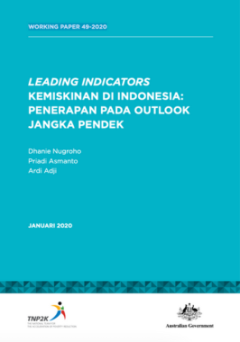
Leading Indicators Kemiskinan Di Indonesia: Penerapan Pada Outlook Jangka Pendek
Indikator pembangunan berjalan sangat dinamis sejalan dengan program dan respons kebijakan pemerintah. Oleh karena itu, pemerintah membutuhkan perkiraan angka kemiskinan pada suatu periode tertentu sesuai dengan perkembangan indikator pembentuknya. Angka tersebut dibutuhkan oleh pemerintah untuk memastikan kebijakan yang dijalankan dapat mencapai sasaran sesuai dengan yang telah direncanakan. D…
- Edisi
- KERTAS KERJA 49-2020
- ISBN/ISSN
- -
- Deskripsi Fisik
- 33 Halaman ; 30 cm, PDF
- Judul Seri
- Working Paper
- No. Panggil
- 362.509598 DHA l

In Data We Trust? An Analysis Of Indonesian Socio-Economic Survey Data
What if a popular data set that has generated a long stream of literature has been misunderstood and has led to misleading inferences? In this paper, we use the case of household expenditure in the Indonesian National Socio-Economic Survey data, SUSENAS, which started over 50 years ago. Appropriate use of SUSENAS for policy analysis requires an understanding that the expenditure variable in SUS…
- Edisi
- Working Paper 2
- ISBN/ISSN
- -
- Deskripsi Fisik
- PDF, 24 Halaman
- Judul Seri
- Working Paper
- No. Panggil
- 300.72 JOH i
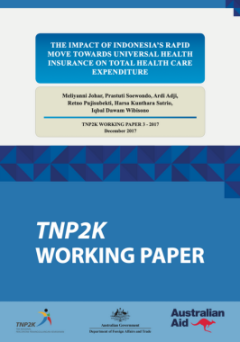
The Impact of Indonesia’s Rapid Move Towards Universal Health Insurance on …
Social health insurance in Indonesia dates from the 1990s but recently in 2014, the government announced its ambition to achieve universal coverage within five years. Jaminan Kesehatan Nasional (JKN) integrates all existing social health insurance schemes under one manager and one payer, the central Ministry of Health. Compared to previous schemes, JKN offers more generous benefits and can be a…
- Edisi
- TNP2K Working Paper 3 - 2017
- ISBN/ISSN
- -
- Deskripsi Fisik
- iii, 31 Halaman, PDF
- Judul Seri
- Working Paper
- No. Panggil
- 368.42 JOH t
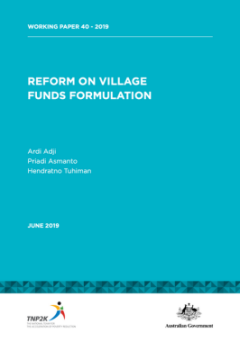
Reform On Village Funds Formulation
The Law No. 6 of 2014 about the Village brought fundamental changes in the management, arrangement and implementation of village governance. In village finances, the law governs the source of village income which can implicates the budget allocation for the village, both sourced from the central budget as well as the regional budget. Since the year 2015, the allocation of village funds increase…
- Edisi
- Working Paper 40 - 2019
- ISBN/ISSN
- -
- Deskripsi Fisik
- PDF, 21 Halaman
- Judul Seri
- Working Paper
- No. Panggil
- 352.14 ADJ r
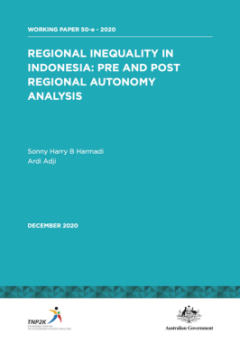
Regional Inequality in Indonesia: Pre And Post Regional Autonomy Analysis
The era of reform in Indonesia was initially triggered by the monetary crisis that Indonesia experienced in June 1997, marked by the sharp decline in the value of the Rupiah, Indonesia’s national currency. In the year 1999, Law No. 22/1999 on Regional Autonomy and then Law No. 25/1999 on Fiscal Balance between the central and regional governments. Both of these laws would later serve as an �…
- Edisi
- Working Paper 50-e - 2020
- ISBN/ISSN
- -
- Deskripsi Fisik
- PDF, 38 Halaman
- Judul Seri
- Working Paper
- No. Panggil
- 320.9598 HAR r
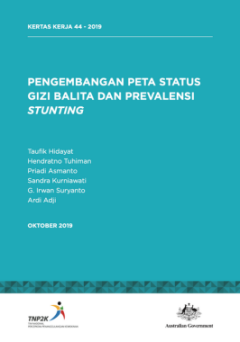
Pengembangan Peta Status Gizi Balita dan Prevelansi Stunting
Indonesia masih menghadapi tantangan besar dalam isu kekurangan gizi kronis pada balita, yang ditunjukkan oleh tingginya prevalensi balita stunting. Untuk mengukur efektivitas dan mempertajam penargetan upaya pencegahan stunting, pemerintah memerlukan informasi mengenai tingkat dan sebaran prevalensi balita stunting pada tingkat wilayah administrasi yang lebih rendah dari tingkat kabupaten/kota…
- Edisi
- Kertas Kerja 44 - 2019
- ISBN/ISSN
- -
- Deskripsi Fisik
- PDF, 48 Halaman
- Judul Seri
- Working Paper
- No. Panggil
- 362.196398 SUR p
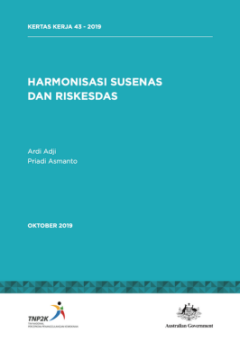
Harmonisasi Susenas dan Riskesdas
Keberhasilan program penurunan prevalensi stunting memerlukan data dan informasi yang akurat dan tepat waktu sebagai dasar penetapan target dan tujuan yang ingin dicapai. Riskesdas digunakan untuk menghasilkan indikator guna melihat status kesehatan masyarakat Indonesia dan memantau berbagai keberhasilan program pemerintah di sektor kesehatan, sementara itu Susenas digunakan untuk menghasilkan …
- Edisi
- Kertas Kerja 43 - 2019
- ISBN/ISSN
- -
- Deskripsi Fisik
- PDF, 20 Halaman
- Judul Seri
- Textbook dan Working Paper
- No. Panggil
- 362.109598 ADJ h
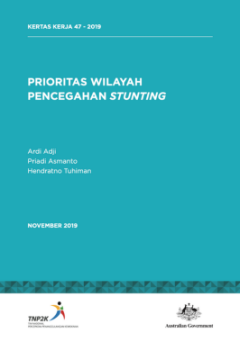
Prioritas Wilayah Pencegahan Stunting
Salah satu faktor kesehatan yang masih membutuhkan perbaikan adalah stunting. Indonesia adalah negara dengan prevalensi stunting tertinggi kelima di dunia. Untuk mencapai target angka stunting sebesar 28% sebagaimana dalam RPJMN 2015-2019, pemerintah pada tahun 2018 telah menetapkan prioritas wilayah pencegahan stunting di 100 Kabupaten/Kota dan diperluas secara bertahap sampai dengan tahun 202…
- Edisi
- Kertas Kerja 47 - 2019
- ISBN/ISSN
- -
- Deskripsi Fisik
- PDF, 25 Halaman
- Judul Seri
- Textbook dan Working Paper
- No. Panggil
- 362.196398 ADJ p
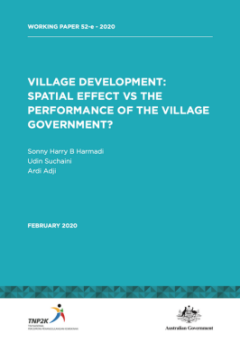
Village Development: Spatial Effect Vs The Performance of The Village Governm…
Village funding in the amount of Rp 257.2 trillion in the past five years (2015-2019) uses a scheme that shares funding equitably. This is evident from the proportion of village funds (90 percent) that was divided equally (2015-2017) (Ministry of Finance, November 2017). This study aims to prove that the achievements of village development are not only due to the impact of the Village Fund Prog…
- Edisi
- Vol 02/No. 01-02- June 2021
- ISBN/ISSN
- 977 2746857002
- Deskripsi Fisik
- PDF, 172 Halaman
- Judul Seri
- Working Paper
- No. Panggil
- 300.5 HAR. V
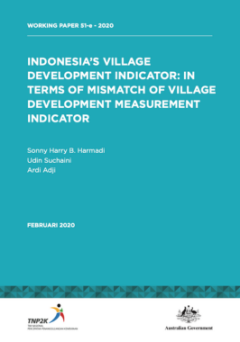
Indonesia’s Village Development Indicator: In Terms Of Mismatch Of Village …
The aim of this paper is to analyse the achievement of village development indicators in 2014 and 2018 after the release of Rp 250 trillion in Village Funds since 2015. There are three indicators related to village development in Indonesia, namely the Geographical Difficulty Index (Indeks Kesulitan Geografis: IKG) which is used as the basis for the Allocation Formula of the Village Fund and the…
- Edisi
- WORKING PAPER 51-e - 2020
- ISBN/ISSN
- -
- Deskripsi Fisik
- PDF, 36 Halaman
- Judul Seri
- Working Paper
- No. Panggil
- 307.72 HAR. I
 Karya Umum
Karya Umum  Filsafat
Filsafat  Agama
Agama  Ilmu-ilmu Sosial
Ilmu-ilmu Sosial  Bahasa
Bahasa  Ilmu-ilmu Murni
Ilmu-ilmu Murni  Ilmu-ilmu Terapan
Ilmu-ilmu Terapan  Kesenian, Hiburan, dan Olahraga
Kesenian, Hiburan, dan Olahraga  Kesusastraan
Kesusastraan  Geografi dan Sejarah
Geografi dan Sejarah